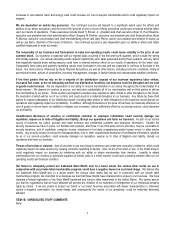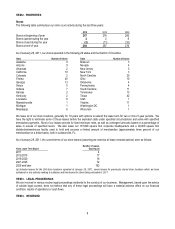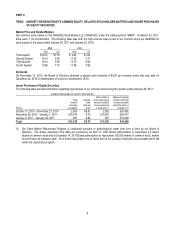Stein Mart 2010 Annual Report Download - page 19
Download and view the complete annual report
Please find page 19 of the 2010 Stein Mart annual report below. You can navigate through the pages in the report by either clicking on the pages listed below, or by using the keyword search tool below to find specific information within the annual report.17
Retail Inventory Method and Inventory Valuation. Merchandise inventories are valued at the lower of average cost or market, on a
first-in first-out basis, using the retail inventory method (RIM). RIM is an averaging method that is widely used in the retail industry.
The use of RIM results in inventories being valued at the lower of cost or market as markdowns are taken as a reduction of the retail
values of inventories.
Based on a review of historical markdowns, current business trends and seasonal inventory categories, additional inventory reserves
may be recorded to reflect estimated markdowns which may be required to liquidate certain inventories and reduce inventories to the
lower of cost or market. Management believes its inventory valuation methods approximate the net realizable value of clearance
inventory and result in valuing inventory at the lower of cost or market.
We perform physical inventory counts at all stores annually. Included in the carrying value of merchandise inventories is a reserve for
shrinkage. Shrinkage is estimated based on historical physical inventory results as a percentage of sales for the year. The difference
between actual and estimated amounts in any year may cause fluctuations in quarterly results, but is not a factor in full year results.
Vendor Allowances. We receive allowances from some of our vendors primarily related to markdown reimbursement,
damaged/defective merchandise and vendor compliance issues. Vendor allowances are recorded when earned. Allowances
received from vendors related to profitability of inventory recently sold are reflected as reductions to cost of merchandise sold in the
later of the period that the merchandise markdown is incurred or the allowance is negotiated. Allowances received from vendors
related to damaged/defective inventory are reflected as reductions to the cost of merchandise as it is received. Allowances received
due to compliance issues (primarily violations of shipping and merchandise preparation requirements) are reflected as a reduction of
the cost of the merchandise when compliance issues are identified during the receiving process. Although it is unlikely that there will
be a significant reduction in historical levels of vendor support, if a reduction were to occur, we could experience higher cost of
merchandise sold.
Impairment of Long-Lived Assets. Long-lived assets are reviewed for impairment whenever events or changes in circumstances
indicate that the carrying amount of an asset may not be recoverable. Factors used in the review include management’s plans for
future operations, recent operating results and projected cash flows. For long-lived assets held for use, an impairment loss is
recognized if the sum of the future undiscounted cash flows from the use of the assets is less than the carrying value of the assets.
The amount of the impairment charge is the excess of the carrying value of the asset over its fair value. Fair value, as used in our
asset impairment calculations, is the price that would be received to sell an asset in an orderly transaction between market
participants at the measurement date. Based on our historical experience, the resale value of used fixtures and equipment is de
minimis and since we lease all our store locations, our leasehold improvements cannot be sold in a market transaction, and therefore
have little to no fair value. Impairment reviews are performed for individual stores during the fourth quarter, or more frequently should
circumstances change. A significant change in cash flows could result in an increase in asset impairment charges. During 2010, we
recorded $1.2 million in pre-tax asset impairment charges related to stores closed in 2010, stores closing in 2011 and certain other
under-performing stores.
Store Closing Costs. We record costs associated with store closing activities when they are incurred, generally the cease-use date.
Lease termination costs are recorded net of estimated sublease income that could reasonably be obtained for the properties. In the
event we are not successful in subleasing closed store locations, additional store closing costs may be recorded. During 2010, we
recorded $1.9 million in pre-tax store closing charges related to stores closed or relocated in 2010.
Insurance Reserves. We use a combination of insurance and self-insurance for various risks including workers’ compensation,
general liability and associate-related health care benefits, a portion of which is paid by the covered employees. We are responsible
for paying the claims that are less than the insured limits. The reserves recorded for these claims are estimated actuarially, based on
claims filed and claims incurred but not reported. These reserve estimates are adjusted based upon actual claims filed and settled.
The estimated accruals for these reserves could be significantly affected if future claims differ from historical trends and other
actuarial assumptions. As of January 29, 2011 and January 30, 2010, insurance reserves of $14.9 million and $16.3 million,
respectively, were included in accrued liabilities. Adjustments to earnings resulting from changes in trends and other actuarial
assumptions have not been significant in 2010, 2009 and 2008.
Valuation Allowance for Deferred Tax Assets. Income tax accounting guidance requires that companies assess whether valuation
allowances should be established against deferred tax assets based on consideration of all available evidence using a "more likely
than not" standard. In making such assessments, significant weight is to be given to evidence that can be objectively verified. A
company's current or previous losses are given more weight than its future outlook.
We perform a quarterly assessment of our net deferred tax assets to determine realization. During the fourth quarter of 2008, we
established a valuation allowance against deferred tax assets because 2008 operating results produced a cumulative three-year loss,
























